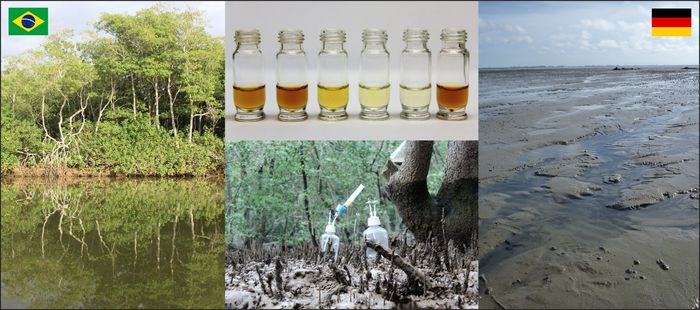MARDOS
DFG-Project: Are permeable coastal sediments hotspots for the formation of non-volatile dissolved organic sulfur (DOS) in the ocean?
Sulfur is essential for life. It also exerts major influence on Earth's climate because as sulfate it creates condensation nuclei in the atmosphere for clouds formation. Marine life in the sunlit ocean continuously takes up and releases various forms of sulfur. In the deep sea, however, dissolved organic sulfur (DOS) compounds have accumulated over millennia to the largest pool of organic sulfur in the oceans. Based on the little available information, sulfur could be the third most abundant heteroelement in marine dissolved organic matter (DOM), after oxygen and nitrogen. However, knowledge on DOS molecular composition, sources and turnover is very scarce.
Within the marDOS project, a DFG-FAPERJ cooperative project (DI 842/6-1) between Germany (Carl von Ossietzky Universität Oldenburg) and Brazil (Universidade Estadual Norte Fluminense), we investigate the formation, transport and fate of DOS at the interface between coastal and marine ecosystems. By the combination of elemental and molecular analyses, we aim to (1) analyze large DOM datasets of sulfidic coastal sediments in Amazonian mangroves of Brazil and intertidal flats in north Germany; and (2) compare our findings in DOS biogeochemistry to other oxygen-limited marine environments where sulfur may play an important role, such as anoxic basins or upwelling systems.
Funding:
DFG
List of people involved:
Gonzalo Gomez
Michael Seidel
Jomar Marques
Thorsten Dittmar
External Collaborators:
Key publications:
Nóbrega MS, Silva BS, Tschoeke DA, Appolinario LR, Calegario G, Venas TM, Macedo L, Asp N, Cherene B, Marques JSJ, Seidel M, Dittmar T, Santos IR, de Rezende CE, Thompson CC, Thompson FL (2022) “Mangrove microbiome reveals dominance of sulfur metabolism in tropical coastal waters”, Science of the Total Environment, 813: 151889; doi.org/10.1016/j.scitotenv.2021.151889
Cabral A, Dittmar T, Call M, Scholten J, Rezende C, Asp N, Gledhill M, Seidel M, Santos, I (2021) “Carbon and alkalinity outwelling across the groundwater-creek-shelf continuum off Amazonian mangroves”, Limnology and Oceanography Letters, doi.org/10.1002/lol2.10210
Gomez-Saez, G.V., Pohlabeln, A.M., Stubbins, A., Marsay, C.M., Dittmar, T. (2017) Photochemical alteration of dissolved organic sulfur from sulfidic porewater. Environmental Science & Technology 51, 14144-14154 (doi: 10.1021/acs.est.7b03713).
* Pohlabeln, A.M., Gomez-Saez, G.V., Noriega-Ortega, B.E., Dittmar, T. (2017) Experimental evidence for abiotic sulfurization of marine dissolved organic matter. Frontiers in Marine Science 4, 1-11 (doi: 10.3389/fmars.2017.00364).
Gomez-Saez, G.V., Niggemann, J., Dittmar, T., Pohlabeln, A.M., Lang, S.Q., Noowong, A., Pichler, T., Wörmer, L., Bühring, S.I. (2016) Molecular evidence for abiotic sulfurization of dissolved organic matter in marine shallow hydrothermal systems. Geochimica et Cosmochimica Acta 190, 35-52 (doi: 10.1016/j.gca.2016.06.027).
Pohlabeln, A.M., Dittmar, T. (2015) Novel insights into the molecular structure of non-volatile marine dissolved organic sulfur. Marine Chemistry 168, 86-94 (doi: 10.1016/j.marchem.2014.10.018).
Seidel, M., Beck, M., Riedel, T., Waska, H., Suryaputra, I. G. N. A., Schnetger, B., Niggemann, J., Simon, M., Dittmar, T. (2014) Biogeochemistry of dissolved organic matter in an anoxic intertidal creek bank. Geochimica et Cosmochimica Acta 140, 418–434 (doi:10.1016/j.gca.2014.05.038).
* awarded with the Paul Crutzen Prize 2018 as best paper in Environmental Chemistry and Ecotoxicology of 2018 (Gesellschaft Deutscher Chemiker, GdCh



![[Translate to English:]](/f/5/_processed_/3/2/csm_ICBM-Logo-transparent-_91fe1c6774.png)
